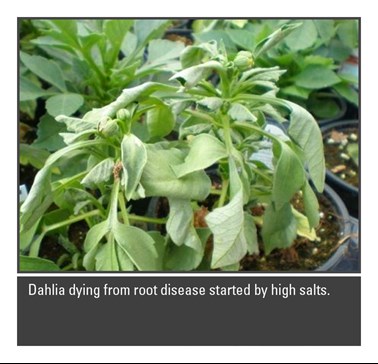Training Center
Growing Tough Crops: Dahlias
Thursday, September 7, 2023 | Ed Bloodnick
Dahlias can be tough to grow as they are sensitive to root disease. Unlike other crops that become less sensitive to root disease once they have a well developed root system, dahlias are still very susceptible even at the end of the crop cycle. At this stage most crops can take some overwatering, so less care is needed when it comes to watering, but dahlias still need proper dry-down to avoid root disease problems. Below is a discussion of the ideal growing conditions for dahlias produced from seed or cuttings and under which root disease or other problems could occur if these growing tips are not followed.
Environmental Conditions
Dahlias are facultative short-day plants, meaning that they flower and produce tubers when the day length is less than 12-13 hours. They prefer warm growing medium temperatures of 65-75°F (18-24°C) during the day and 60-65°F (15-18°C) at night. Colder temperatures greatly slow vegetative growth, encourage tuber development, delay flowering and produce ideal conditions for root disease; on the other hand, warmer temperatures can encourage rapid, weak growth that easily topples over in the container. Dahlias grow best under high light and long days of at least 12-13 hours of light.
Nutrition
Vegetative dahlias can be heavy feeders, whereas the seed-propagated varieties require less fertilizer. For seed propagation, begin fertilization once the first set of true leaves emerges. Apply fertilizer at a constant application rate of 75-100 ppm and maintain this rate throughout the plug stage. For vegetative propagation, begin fertilization once the roots extend from the cutting to the edges of the root ball. Initial constant feed application rates should be 75-100 ppm nitrogen and then gradually increase to 150-200 ppm during the propagation stage.
After transplanting seed-propagated plants, increase constant fertilizer application rate to 100-150 ppm nitrogen; for vegetative-propagated dahlia, the suggested constant application rate is 225-300 ppm nitrogen. Dahlias are sensitive to high salt levels which can damage roots, creating entry points for root pathogens, so monitor the electrical conductivity (E.C.) which measures salts coming from the fertilizer, water and any injected acids. For vegetative plants, do not allow the growing medium E.C. to exceed 2.5 mmhos/cm; seed-propagated plants should not have an E.C. above 2.0 mmhos/cm.
At these recommended feeding rates, vegetative dahlias will have a greater risk of being exposed to a high E.C., so E.C. should be monitored on a weekly basis and frequent leaching is suggested. It may be better to apply fertilizer at a rate of 225 ppm nitrogen to minimize salt build-up, but not below 150 ppm nitrogen as this will develop weak, chlorotic plants with premature flowering. Avoid using fertilizer with a high phosphorus level as it can cause stretching and floppy top growth.
Root diseases
Dahlias are susceptible to attacks from root pathogens at any growth stage. As mentioned above, salt build-up in the growing medium can damage roots and create entry points for Pythium and Rhizoctonia, and overwatering can cause root stress, also making them susceptible to root pathogens.
Once the root system is damaged and diseased, these roots cannot absorb water from the growing medium. Since the plant cannot efficiently use the water, the medium dries out more slowly than with neighbouring plants and it then becomes overwatered. Since conditions are more favourable for root pathogens, they spread to other parts of the root system, causing the plant to wilt and eventually die. Initially this occurs with a few plants here and there within the crop. If the salts and/or watering issue is not addressed, then many more dahlias could die from root disease.

Avoiding the high E.C. and disease trap
First, plant your dahlias in PRO-MIX® HP BIOFUNGICIDE™* + MYCORRHIZAE™. It is a high porosity growing medium that drains well, has good aeration and is amended with a natural biofungicide to suppress Fusarium, Pythium and Rhizoctonia. Next, it is important to fertilize at lower application rates and monitor salts. This will reduce plant stress and minimize root damage. Make sure plants are adequately spaced and that there is a good airflow to encourage a faster dry-down of the growing medium. Allow the growing medium surface to turn a light brown to tan color before watering as Pythium thrives in saturated growing media.
*BIOFUNGICIDE™ is only available in the United States. All BIOFUNGICIDE™ products are available under BIOSTIMULANT in Canada and Latin America. For more information, ask your Sales Representative.
If you have more questions about growing dahlias, contact your plant supplier or your Premier Tech Grower Services representative for more information on using the proper growing medium for your crops.
 |
 |
 |
 |
|---|---|---|---|
|
Ed Bloodnick |
Nathan Wallace-Springer |
Lance Lawson |
Victor Brantly |
 |
 |
 |
|
|
Troy Buechel |
Susan Parent |
Jose Chen Lopez |
PRO-MIX® is a registered trademark of PREMIER HORTICULTURE Ltd.

 Where to find our products
Where to find our products
